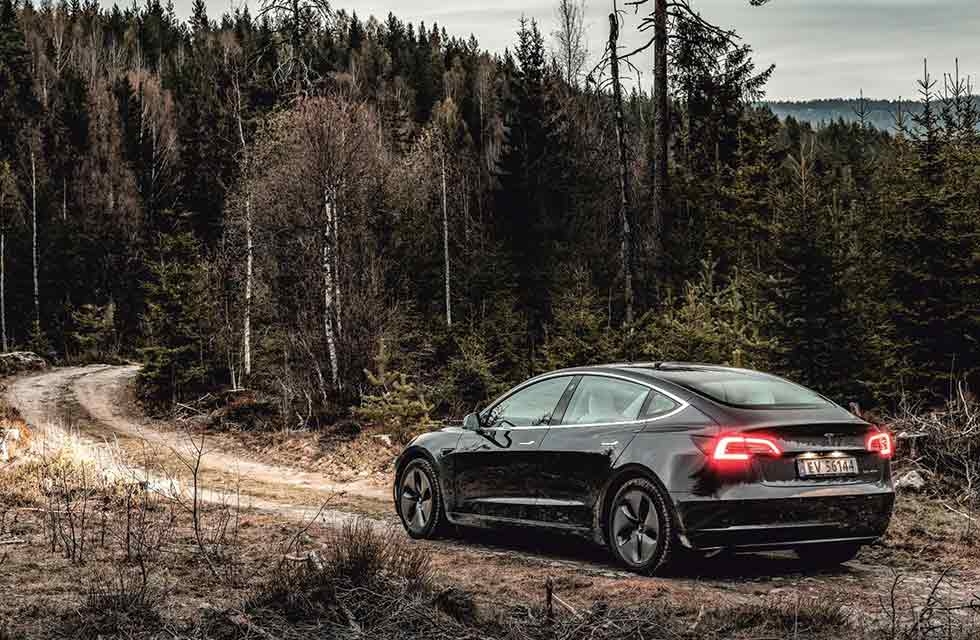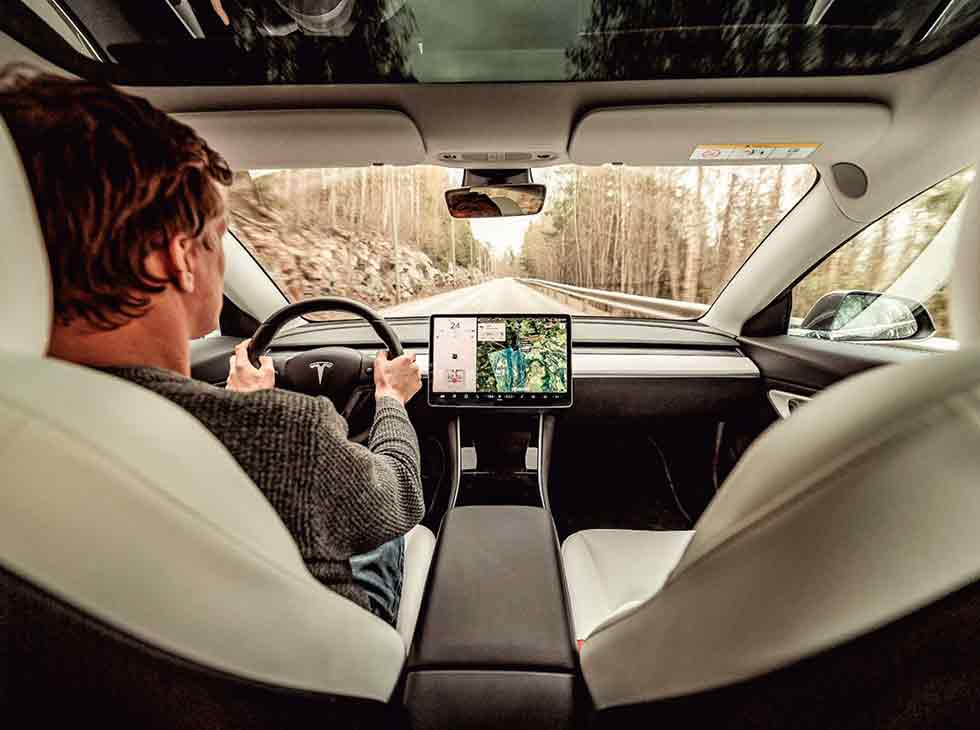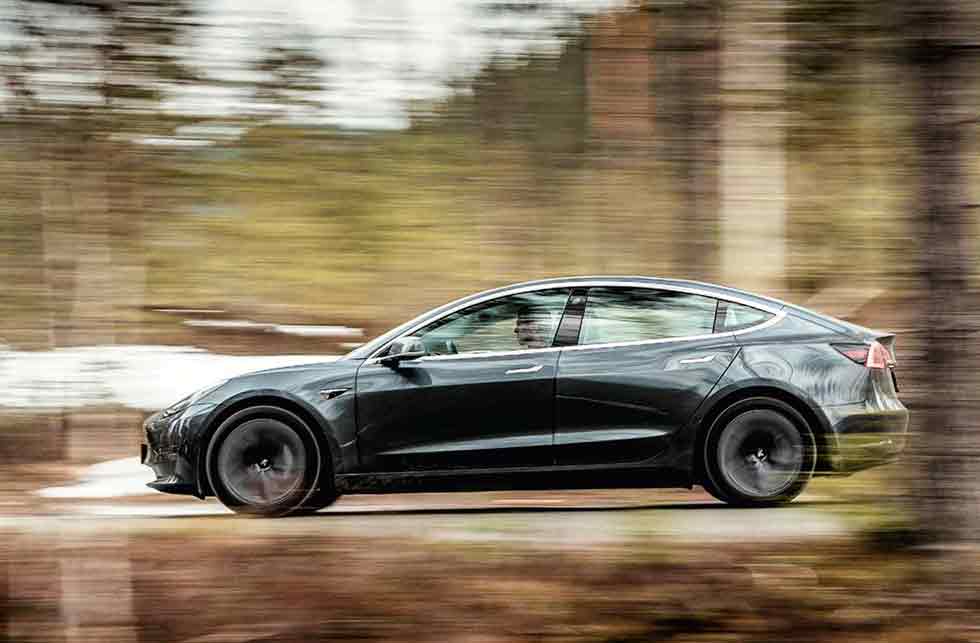
Tesla Model 3 Off grid. Embattled Tesla’s much-hyped mass-market car is finally reaching the UK. Just before it lands, we spend 300 miles in a possible future. Words Mike James Taylor. Photography Alex Tapley.
The 300-mile test new car meets real world
It’s fast. There’s no Ludicrous mode – that’s saved for the higher-end Model S and X – but frankly, it doesn’t need one

Like you, I have a lot of questions about the Tesla Model 3. But the most important one – whether it is a car you should genuinely consider buying – I think I can answer now. Yes, it is.
I think I can answer your most pressing Model 3 question now – yes, this is a car you should consider buying

Between now and that conclusion there’s a day and a half and more than 300 miles to cover, so let’s start at the beginning. Why are we in Norway to drive the Model 3, not in the UK? As we go to press, it’s just about to go on sale in the UK; by the time this magazine is in your hands, it will be. First deliveries are slated for June, if you were early to the queue. Other than the steering wheel having traded places with the glovebox, there’ll be no discernible difference between the car you can buy in the UK and the one that’s already on sale in Scandinavia. So, like a kid sneaking downstairs early on Christmas day, we’ve snuck over to northern Europe to get to know it properly in advance. And Norway is the European epicentre of electric car popularity; tax exemption and incentives make it boomtown for EVs.
The acceleration isn’t a surprise but the flat cornering stance and taut body control are, especially for a 1.8-tonne car
Almost 60 per cent of new cars sold in the country in March were pure EVs, a new record, bolstered in no small part by the release of the Model 3. On the short schlep from Skøyen train station to the Tesla centre from which we’re borrowing the Model 3, one in five cars we pass is a Model S, 3 or Model X (snigger). The newest, littlest Tesla has only been on sale here since February but pent-up demand meant it accounted for 29 per cent of all new car sales in March. Tesla’s first mass-market car is a big deal here.

An hour later we’re another EV on Oslo’s streets, pointing the Model 3’s grilleless nose out of Tesla-Skøyen (a hip-looking brick-built former railway workshop in a regenerated area of town – very on-brand) and into the throng. We’re sitting in an interior quite unlike any I’ve experienced outside of a concept car; there are only four physical switches (hazard lights and SOS e-call buttons above the rear-view mirror, and a pair of clickable scrollers on the wheel), plus two conventional stalks. The right-hand one is a column-shift gear selector; like the Model S, the 3 is so straightforward to operate as to be almost disconcerting. You don’t physically switch it on, or even unlock it – just approach it with your phone in your pocket (which essentially becomes the key once it’s paired), climb in, push the column to D and off you go. The left stalk is a wipers/indicators combo.
For the first couple of turns I embarrass myself by inadvertently leaving the indicators winking, partly because they’re a soft-return, one-touch job of the type that’s recently been abandoned by BMW, but mostly because their only visual cue is on the 15-inch central touchscreen that dominates the minimal cabin. It’s the sole display for driver and passengers alike, and speedometer, range info, air-con, headlights – everything – it’s all on here.
At first glance it’s as if somebody’s computer desktop display has been attached to the dashboard, and yet – the indicator thing aside, which you quickly adapt to – the display is extremely logical. Driving stuff to the left, everything else to the right. The rest of the cabin is ruthlessly de-cluttered; there are no conventional air vents, replaced by one continuous fissure across the dash. You control the direction and temperature of air flowing from the gap by dragging your finger across an animated diagram on the touchscreen. It’s more intuitive than you might expect, and looks kind of cool to boot. The screen is less distracting than I’d expected, too. The way it translates a vague finger-prod into decisive action is quite uncanny, and its menus and command steps are remarkably easy to navigate.
Gliding in and out of the city’s outer ringroads, the Model 3 is a serene experience. Like many EVs, energy-regenerating braking makes it practically a one-pedal car; lift your foot from the accelerator and it decelerates sharply, as if an unseen driving instructor has jumped on the dual-controls. You can choose from a less abruptly decelerative mode for the regen via the touchscreen, and also toggle whether the car creeps from rest when you take your foot from the brake, or stays put. You can also choose three levels of weighting for the power steering; in its heaviest mode it transforms into something almost like a sports car’s, brimming with feedback. An empty on-ramp beckons and I experimentally give the accelerator a firm push. Whoosh. Jeepers, it’s fast. There’s no Ludicrous mode – that’s saved for the higher-end Model S and X – but frankly, it doesn’t need one.
When this magazine first tested the Model 3 in May 2018 it was available only in America, and at that point only in single- motor, rear-wheel-drive form. The line-up has expanded since: this is a Dual Motor All-Wheel-Drive car. UK prices start from £38,900 for the rear-drive Standard Range Plus version with the smallest-capacity battery pack (258 miles, 5.3sec to 60mph), while the AWD Long Range (beefier battery pack, 348 miles, 4.5sec) – tested here – is £47,900. The range-topping AWD Performance (bigger 20-inch tyres, 3.2sec, 329 miles) is £56,900. So the Model 3 is not a cheap car, but it is the most attainable Tesla yet – and the first truly mass-market one, with ambitions of shifting half a million cars a year in 2020. Industry onlookers have posited that same ambition might break the company – and may yet if the cards fall skew-whiff. Tesla has posted big losses of late, most recently $702m in its first quarter earnings report, and a large proportion is reportedly attributed to the challenges of pushing Model 3 production to mass-market levels. Production was halted for five days in February to fix bottlenecks, and the rate of production has many rivers to cross to reach its projected targets.
This car sports some Blue Peter-spec panel gaps, and its touchscreen will later have a brief wobble, overlaying two displays at once. (Switching it off and on again cured it – classic IT.) But overall it feels entirely sound. Refinement, certainly, is on the money. There’s a bit of wind rustle and a whirring from the heavily treaded winter tyres, but it’s a well-insulated machine.
Drivers in Norway are unerringly polite, with impeccable lane discipline and a zen-like lack of aggression. But there’s a lot of them. Traffic doesn’t thin until finally, south of Nottenden, we find ourselves on a deserted road. And it’s a great one – undulating, scenic and with perfect, unblemished tarmac.
The Model 3 makes a surprisingly good fist of it. The acceleration isn’t a surprise – it has two instant-torque electric motors – but the flat cornering stance and taut body control are, especially for a 1.8-tonne car. Unlike the pricier Model S, the Model 3 doesn’t have air suspension, instead using fixed dampers and coil springs, double wishbone at the front, multi-link at the rear. It resists roll like a track car, and yet the ride quality is smooth and acceptable on this Long Range model’s 18-inch wheels (sportier-looking 19s are an option). By shifting weight onto the front wheels every time you lift from the accelerator, the regenerative braking helps tuck the nose in. Drive quickly and the balance feels more progressive and natural if you select the less aggressive regen setting. The shorter wheelbase makes the 3 more fun than the Model S, and swooshing from apex to apex in this silent assassin is actually more fun than most cars. Don’t get me wrong; a BMW 3-series would be more fun still. But the BMW lacks the Tesla’s desirablity and strong character.
Dimensionally, the Model 3 is roughly the same length as a 3-series but its EV package allows a bigger interior. In profile its tall, curving glass roof makes it look like a glass-blowing exercise. It’s a five-seater, and the rear bench offers decent legroom, if not quite as much headroom for taller passengers as you might hope. There are two boots, the rear generous and the front pokier, its chief use being to store the charging cables, of which this car had two – one for a conventional power outlet, one for Tesla’s high-speed Supercharger charging network, plus a CCS adapter for third-party fast-chargers.
Theoretically the all-wheel-drive Model 3 should easily complete the 300-mile test on a single charge but we’ve been plugging into the company’s rapid Supercharger network as we go, topping up little and often to be on the safe side. In Norway we’re spoiled for choice, the navigation system peppered with Supercharger sites; in the UK there are currently around 300 of them, a little far flung for absolute convenience at present but with more on the way. They are startlingly convenient, and fast; pull up, pick a bay, plug in. The fee is automatically billed to your MyTesla account at 24p per kWh in the UK. Within a few minutes you’ve got another 50 miles in the metaphorical tank. It does nonetheless mean you’ll spend accumulated hours each month killing time in nondescript areas (the Superchargers we found were predominantly at the back of petrol stations and retail parks), buying snacks and coffees you don’t really want or need. Most Tesla owners we spotted were simply holed up in their cars on their phones, waiting. But as a convenient quick-stop- and-top-up, it’s hard to fault.
Grinding back through clogged traffic on the return leg into Oslo presents the perfect proving ground for Autopilot. A double-tab on the column-shifter activates the system, which steers, accelerates and brakes autonomously, and can also change lane by itself at the driver’s command via the indicator stalk – a manoeuvre it reticently takes its time to do, though better that than botching it I guess. Autopilot is smooth and adept, although far from infallible, occasionally braking sharply for no apparent reason, and steering with a woolly lack of conviction. It’s at its best when it has a guardrail to follow. But before long you’re trusting it to pull to a halt and pull away again in traffic, and it’s easy for your attention to wander, so it’s for the best that the system requires that you keep your hands on the wheel, cancelling the operation if it detects pressure is removed for a certain length of time.
If customers are willing to pay £4900, additional preparation for ‘full self-driving capability’ is added, with planned over-the-air updates permitting greater and greater levels of autonomy, including in cities, and even potentially a driverless valet-style function for car parks. It’s technology that’s being investigated elsewhere, but Tesla’s bullishly accelerative thinking, its drive to do things rather than talk about them, and to do them its own way is writ large in the Model 3. Not a perfect car, but a fascinating one.
THE 300-MILE VERDICT
Rivals race to catch up with the Model 3’s car-as-smartphone user experience
It says much for the Model 3’s sheer charisma that you can find yourself overlooking an awful lot of niggles: the aforementioned iffy panel gaps and associated doubts about its long-term reliability; the Orwellian connectedness of a car whose secondary functions are intrinsically bound up in the internet (although that’s a factor that will surely soon apply to the majority of new cars); the cliquishness that owning one broadcasts to the world; the trust you place in a car that relies so heavily upon touchscreen control should that screen throw a fit.
And yet. The Model 3’s serene (and surprisingly fun) driving experience, the ultra-modernity of its interior and the sheer now-ness of the car as a whole make its draw inexorable. The touchscreen is surprisingly usable on the move, and its grouping of all of the displays essential to driving less distracting and more accessible than it might seem on first acquaintance , although the potential for catastrophic eyes-off- the-road time is undoubtedly there. The system’s ease – and enjoyment – of use is almost as intrinsic to the Model 3’s appeal as its electric drivetrain. Its car-as-smartphone user experience extends Tesla’s USP as established manufacturers and start-ups race to catch up.
Were a millennial buyer faced with a choice between a Model 3 and a conventional saloon, you’d bet on them choosing the Tesla – assuming they could afford it. The much-trumpeted $35k entry price for the Tesla in the USA (although the majority of 3s sold change hands for higher prices) was never going to translate to a sub-£30k price point in the UK, but nonetheless the £38,900 single-motor price, extending past £60k for an optioned-up AWD Performance, means that the Model 3 remains out of reach for many. But price aside, it’s an immensely usable product, with a practical range – yes, we were driving in Norway, where EV infrastructure is plentiful, but a 300-plusmile range is a huge plus point for the dual-motor Model 3.
I generally don’t feel comfortable using touchscreens on the move, and would put connectivity near the bottom of a car’s dream attributes. And yet I find myself really wanting a Tesla Model 3. It’s that kind of car.
This is an electric car to truly love
Tech-rich, progressive, quick, quiet, calming – the Model 3 is all of these things. But the smallest Tesla is also the first to really connect driver and driving experience – thank its conventional (rather than air-sprung) suspension, more compact size and surprisingly keen steering. Sure, the BMW 3-series maintains a margin of superiority, but that the Tesla is even comparable on dynamics is significant. You can feel smug about owning a Model 3 – and genuinely love driving it.
Going electric? Don’t wait
The Model 3 has endured its fair share of delays but natural rivals remain few and far between. VW’s (smaller) ID Neo will be shown later this year and goes on sale early next year. Want one of BMW’s upcoming 4-series-sized EVs, likely to be badged i4? You’ll have to wait longer still. Meanwhile the superb i-Pace is too expensive, e-Golf lacking in range or wow factor and the still-desirable i3 more city car than long-distance traveller. So join that Tesla waiting list.
Build quality remains an issue
On this evidence, Tesla’s build quality issues persist – though the situation is improving. Panel gaps, much maligned on early cars, are indeed rather poor on this test car. The boot closes with a hollow clatter, too. But overall refinement and solidity feels sound, and the interior is commendably rattle-free – not always the case in other high-end saloons.
Two motors means all-wheel drive and no worries on gravel. These are the 18-inch wheels. 19s are an option Even a Rolls- Royce can’t offer a log fire on demand. How the locals do it: take on charge, cool your socks. Who left that monitor there?! Oblong control centre feels normal in moments.
If the handbrake fails, are all the fish electrocuted?
James loves roads like this. So, too, does the Model 3.
There’s real brilliance here (glossed with a gleefully puerile sense of humour).
300-mile test
PICK-UP: 0 MILES
You don’t have anything so outmoded as a key. This card is paired with the car via the Tesla app; your phone can be too. Tap the card on the B-pillar to gain access.
12 MILES
The nav (satellite graphics by Google, guidance by actual satellites) is pretty good and mostly intuitive. If your passenger brings up another display, such as Spotify, however, it replaces the map; watch you don’t miss a turn.
Plant the throttle and you’ll hit 124mph in 7.9sec – and be in jail shortly after
85 MILES
‘Summon’ allows you to back your Model 3 forwards or backwards while you stand next to it. We try it at a charging point. There’s a tiny but terrifying fraction of a second’s lag before it stops.
98 MILES
The front seats are 12-way power adjustable and heated as standard, and black. White is a £950 upgrade. We wonder how well or otherwise it might survive scuffs and marks, especially if the rear Isofix points are put to use.
100 MILES
The corner of the touchscreen might seem an odd place for the speedo. But it’s no more time-consuming or distracting than using a conventionally-positioned speedo.
185 MILES
We’ve found another electric car to twin-test the Tesla against. More focused single-seater layout than the Model 3, but excellent headroom and tyres probably cheaper to replace.
210 MILES
Still marvelling at the ventilation controls, marshalled by tracing a finger on the display. Why has no one else thought of that?
260 MILES
Loop north before return to Oslo to visit Europe’s biggest Supercharger station at Nebbenes, a motorway rest stop: 30 chargers and burgers.
390 MILES
We meant to do 300 miles. After nearly 400 we still feel fresh – must be the Model 3’s calmness, even if the seats could be more supportive.
Price £47,900 (£54,700 as tested inc £3500 UK plug-in grant);
Range from £36,900
Performance 346bhp, 389lb ft,
4.5sec 0-60mph,
Max Speed 145mph
Powertrain Dual e-motors, all-wheel drive
Weight 1847kg
Efficiency 348-mile range (WLTP rating),
0g/km CO2
On Sale May 2019
Rating 5/5






